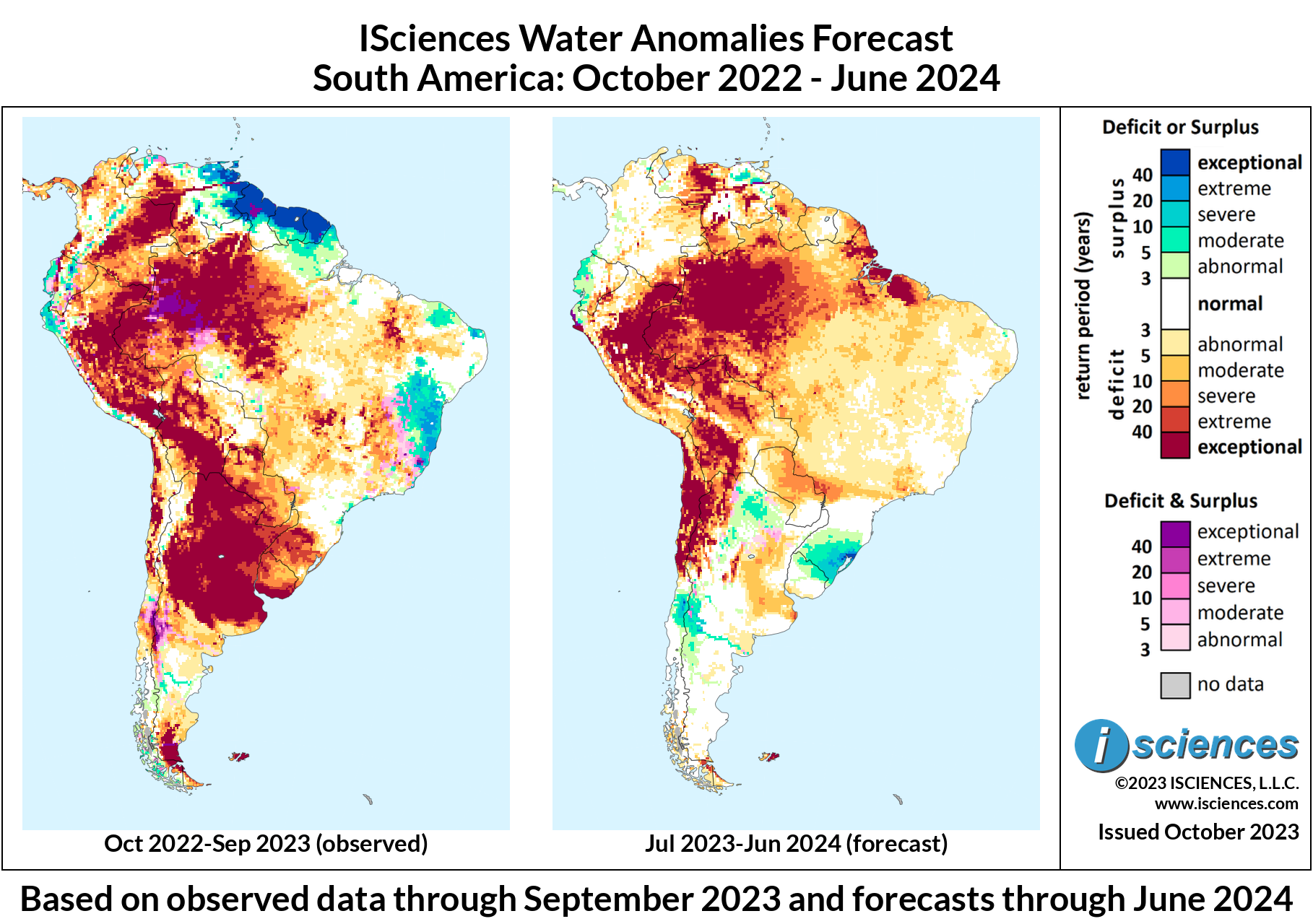South America: Widespread deficits in NW Brazil, Bolivarian Nations
24 October 2023
THE BIG PICTURE
The 12-month forecast ending in June 2024 anticipates exceptional deficits in southern countries to mostly dissipate, though will still continue in northwestern Brazil, as well as the Bolivarian Nations. Exceptional surplus is expected to disappear in the Guianas, becoming near-normal conditions with some moderate deficit.
The map on top depicts long-term deficit and surplus anomalies as of September 2023, while the map on the bottom depicts a forecast of long-term deficits and surpluses as of June 2024.
Extreme to exceptional deficits are expected in the following areas:
Western and northeastern Brazil, widespread throughout the state of Amazonas, as well as in coastal regions of the states of Maranhao and Para.
Peru, widespread throughout much of the region, with the heaviest concentrations appearing in regions east of the Pacaya Samiria National Park, and continuing south into the Mashco Piro Indigenous Reserve, Madre de Dios Territorial Reserve, and across the Peruvian Andes.
Northern Chile, widespread from Arica and into much of the Coquimbo Region. These deficits continue into northwestern Argentina into the San Juan Province.
Southwestern Bolivia, in most areas southwest of the city of Sucre.
Severe to extreme surpluses are anticipated in:
Southern Brazil, with the highest concentration of surplus anomalies appearing north of the Lagoa dos Patos.
Central Chile, appearing near the city of Concepción, into northern regions of the Neuquén Province in western Argentina.
The 3-month maps (below) show the evolving conditions in more detail.
FORECAST BREAKDOWN
The forecast through December 2023 anticipates widespread deficits throughout much of northern countries, with exceptional deficits occurring throughout the Brazilian states of Amazonas and Acre, northern Venezuela, eastern Peru, and northern Guyana. Similar deficits continue further south in southwestern Bolivia and along Chile’s eastern border shared with western Argentina. Intense surplus is expected to expand in southern Brazil, particularly in areas near the Lagoa dos Patos and in northern Uruguay. Some instances of exceptional transitional conditions are anticipated in eastern Brazil in coastal regions of the state of Ceara.
From January through March 2024, anomalies are expected to decrease significantly throughout much of the continent. Some northern regions of Venezuela are expected to observe exceptional deficits, as well as some areas of the Coquimbo Region of Chile. Northern regions of Argentina can expect moderate surplus to occur, as well as western coastal regions of Ecuador and southeastern regions of Colombia.
The forecast for the final months – April 2024 through June 2024 – anticipates most regions to observe near-normal conditions, with some moderate deficits appearing along the western coast of Peru into southwestern Bolivia. Additionally, northernmost areas of Colombia and southern regions of Brazil in the state of Parana can expect moderate surplus.
Please note that WSIM forecast skill declines with longer lead times.
IMPACTS
The Amazon rainforest is currently stricken with intense drought, which is expected to persist. The drought has caused wildfires, diminished air quality for millions of people, and quickly depleted rivers throughout the region. As a fifth of the world’s freshwater flows through the Amazon, one of the rainforest’s major rivers recorded its lowest level on October 16th, while many other nearby rivers are nearing similar levels. Due to the drought, a major hydropower plant in the area has shut down, isolating tens of thousands of people in remote communities. Additionally, the population of endangered pink dolphins has declined due to suffocation from lack of sufficient water.
The port of Manaus recorded 44.6 feet of water on October 16th, its lowest level since records began in 1902. Citizens reported a three month long drought in the area, as well as higher temperatures. Brazil's Science Ministry stated that this year’s is a result of El Nino, and that it expects the drought will last until at least December.
Intense drought in the Amazon is also forcing Brazilian grain exporters to export cargo through southern ports as opposed to northern ports, as they have become too shallow. Northern routes have typically been used to expedite exports of corn and soybeans over the past few years. Brazil is the world's biggest soybean exporter and is expected to surpass the United States this year as the top exporter of corn.
NOTE ON ADMINISTRATIVE BOUNDARIES
There are numerous regions around the world where country borders are contested. ISciences depicts country boundaries on these maps solely to provide some geographic context. The boundaries are nominal, not legal, descriptions of each entity. The use of these boundaries does not imply any judgement on the legal status of any territory, or any endorsement or acceptance of disputed boundaries on the part of ISciences or our data providers.
Subscribe to our monthly Water Watch List
Search blog categories
- *Precip/Temp Outlooks 101
- *Press Releases 1
- *Special Topics 21
- *Water Watch Lists 127
- Africa 130
- Australia & New Zealand 114
- Canada 116
- Central Asia & Russia 114
- East Asia 115
- Europe 121
- Impact Highlights 1
- Mexico & C. Amer. & Carib 119
- Middle East 124
- Proof Point 2
- South America 130
- South Asia 120
- Southeast Asia & Pacific 123
- United States 120
Search blog tags



